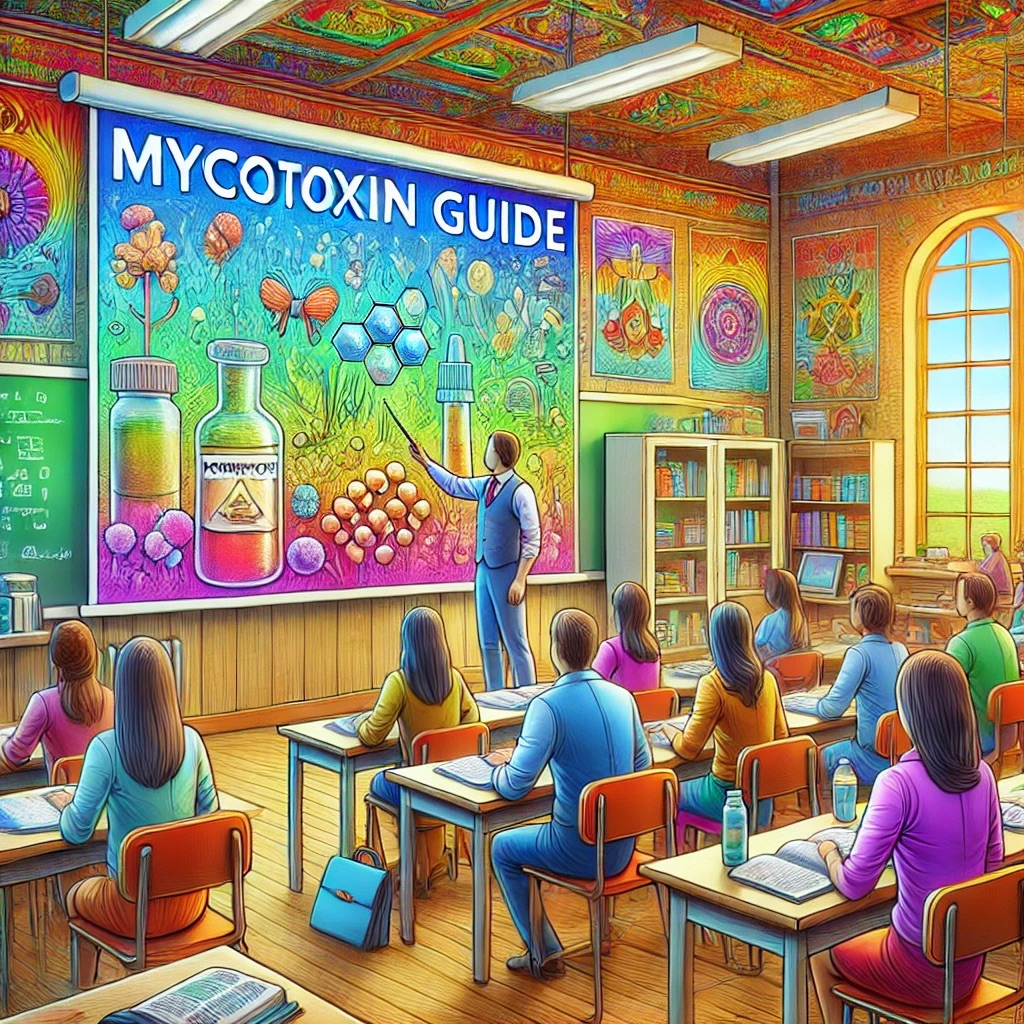The Ultimate Guide for Mycotoxin Illness- Diagnostic Tool
 To win the battle against mold illness, you must know what you’re up against. Most people think mold is the problem when, in fact, mycotoxins are the main issue. For this reason, I created an article summarizing all of the mycotoxins and their effects on human health. This will give you a guide to help you determine which mycotoxin could be contributing to your issues.
To win the battle against mold illness, you must know what you’re up against. Most people think mold is the problem when, in fact, mycotoxins are the main issue. For this reason, I created an article summarizing all of the mycotoxins and their effects on human health. This will give you a guide to help you determine which mycotoxin could be contributing to your issues.
In this guide, I rate all mycotoxins from most to least detrimental. I will also discuss diagnosing mold illness and address many common questions about mycotoxins. Buckle your seatbelts; this will be an unforgettable ride through the world of mold toxins.
The Ultimate Guide for Mycotoxin Illness
Below is the list of all mycotoxins that are produced by toxic molds. Next to each, you will find its effects on human health, level of toxicity, overall rating, and more. Scroll down to get started.
1. Aflatoxins
Severity: ★★★★★ (Highly toxic, carcinogenic)
Produced by: Aspergillus flavus, Aspergillus parasiticus
Effects on Human Health:
Carcinogenic: Aflatoxins, especially Aflatoxin B1, are potent carcinogens linked to liver cancer. Chronic low-level exposure can also promote tumor growth.
Liver Damage: Significant liver toxicity, leading to liver cirrhosis or liver failure in acute cases.
Immune Suppression: Prolonged exposure weakens the immune system, increasing susceptibility to infections.
Developmental Effects: Prenatal exposure can cause growth impairment, developmental delays, and increase childhood cancer risk.
Acute Toxicity: High-level exposure causes aflatoxicosis, characterized by liver damage, jaundice, and possibly death.
Common Exposure: Contaminated food (peanuts, corn, nuts) in regions with hot, humid climates. It can also be found in damp, mold-contaminated homes.
2. Ochratoxin A
Severity: ★★★★★ (Nephrotoxic, carcinogenic)
Produced by: Aspergillus ochraceus, Aspergillus niger, Penicillium verrucosum
Effects on Human Health:
Kidney Damage: Ochratoxin A is a strong nephrotoxin, leading to chronic kidney disease and, in severe cases, kidney failure.
Carcinogenic: Linked to kidney and urinary tract cancers. Long-term exposure is a cancer risk, particularly in people consuming contaminated foods.
Immune Suppression: Ochratoxin A weakens the immune system, making individuals more susceptible to infections.
Neurotoxic Effects: Chronic exposure may result in memory loss, impaired cognitive function, and neurodegeneration.
Teratogenic Effects: Ochratoxin can cause birth defects and fetal toxicity, particularly when exposed during pregnancy.
Common Exposure: Found in stored grains, coffee beans, dried fruits, wine, and water-damaged buildings.
3. Trichothecenes (Satratoxins, T-2 Toxin, and Verrucarin)
Severity: ★★★★★ (Highly cytotoxic, immunosuppressive)
Produced by: Stachybotrys chartarum, Fusarium species, Trichoderma species
Effects on Human Health:
Cytotoxicity: Trichothecenes inhibit protein synthesis, causing nutritional deficiencies, severe cell death, skin rashes, and damage to respiratory tissues.
Immune Suppression: Prolonged exposure causes suppression of immune function, resulting in increased vulnerability to infections.
Respiratory Distress: Inhalation of trichothecenes leads to lung hemorrhaging, chronic coughing, wheezing, and pulmonary inflammation.
Neurological Effects: Severe headaches, dizziness, cognitive impairment, and even permanent neurological damage.
Gastrointestinal Symptoms: Ingestion can cause vomiting, diarrhea, stomach cramps, and malnutrition.
Skin Necrosis: Direct skin contact with trichothecenes can result in severe rashes, blisters, and even necrosis (tissue death).
Common Exposure: Found in water-damaged homes, especially in materials like drywall, carpet, and insulation contaminated with Stachybotrys (“black mold”).
4. Fumonisins
Severity: ★★★★☆ (Carcinogenic, neurotoxic)
Produced by: Fusarium verticillioides, Fusarium proliferatum
Effects on Human Health:
Carcinogenic: Fumonisins are linked to esophageal cancer and possibly liver and kidney cancers.
Neurotoxic Effects: Disrupts the metabolism of sphingolipids, essential for normal brain function, potentially causing neurodegenerative diseases.
Liver and Kidney Damage: Prolonged exposure can result in liver dysfunction and kidney damage.
Developmental Effects: Fumonisins are associated with neural tube defects, such as spina bifida, during pregnancy.
Common Exposure: Found in contaminated corn, corn-based products, and grains, particularly when stored in moist environments.
5. Zearalenone
Severity: ★★★★☆ (Estrogenic, endocrine disruptor)
Produced by: Fusarium species
Effects on Human Health:
Endocrine Disruption: Zearalenone acts as an estrogen mimic, disrupting normal hormone levels. It causes reproductive disorders, including infertility, early puberty in children, and miscarriages.
Reproductive Issues: Prolonged exposure leads to abnormal reproductive organ development and menstrual cycle disruption.
Carcinogenic Potential: Long-term exposure may increase the risk of breast cancer and other hormone-dependent cancers.
Developmental Effects: Causes sexual development disorders in both males and females, especially in utero.
Common Exposure: Found in moldy grains (corn, barley, wheat), especially in damp conditions during storage.
6. Sterigmatocystin
Severity: ★★★★☆ (Carcinogenic)
Produced by: Aspergillus versicolor, Aspergillus sydowii, Chaetomium globosum
Effects on Human Health:
Carcinogenic: Structurally similar to aflatoxins, sterigmatocystin is linked to liver cancer and possibly other cancers after prolonged exposure.
Respiratory Issues: Inhalation of spores or particles contaminated with sterigmatocystin causes chronic coughing, difficulty breathing, and lung inflammation.
Immune Suppression: Weakens the immune system, increasing the risk of infections.
Liver and Kidney Damage: Long-term exposure results in organ dysfunction, particularly affecting the liver and kidneys
Common Exposure: Found in moldy materials in water-damaged buildings, including drywall, wood, and insulation.
7. Patulin
Severity: ★★★★☆ (Cytotoxic, immunosuppressive)
Produced by: Penicillium expansum, Scopulariopsis brevicaulis
Effects on Human Health:
Immune Suppression: Patulin exposure weakens the immune system, increasing susceptibility to infections.
Gastrointestinal Symptoms: Causes vomiting, diarrhea, and stomach cramps in acute exposure cases.
Neurotoxicity: Chronic exposure can lead to headaches, dizziness, and neurological dysfunction.
Carcinogenic Potential: Although evidence is limited, patulin is suspected of contributing to DNA damage and cancer development.
Common Exposure: Found in moldy fruits (especially apples), fruit juices, and contaminated food stored in humid conditions.
8. Citrinin
Severity: ★★★★☆ (Nephrotoxic, cytotoxic)
Produced by: Penicillium citrinum, Penicillium variabile, Aspergillus species
Effects on Human Health:
Kidney Damage: Citrinin primarily affects the kidneys, causing nephrotoxicity and potentially leading to kidney failure with prolonged exposure.
Liver Toxicity: May also cause liver dysfunction, though it primarily targets the kidneys.
Respiratory Problems: Inhalation of citrinin-contaminated particles can lead to respiratory irritation and infections.
Immune Suppression: Prolonged exposure to citrinin weakens the immune system, increasing the risk of infections.
Common Exposure: Found in contaminated grains, rice, and moist indoor environments.
9. Chaetoglobosins
Severity: ★★★★☆ (Cytotoxic)
Produced by: Chaetomium globosum
Effects on Human Health:
Cell Damage: Chaetoglobosins cause cytotoxicity, damaging cells by disrupting actin polymerization, essential for cell structure and movement.
Respiratory Problems: Inhalation of spores contaminated with chaetoglobosins can cause asthma, bronchitis, and chronic lung irritation.
Immune Suppression: Chronic exposure can lead to weakened immune function, making individuals more vulnerable to infections.
Skin Irritation: Direct contact with contaminated surfaces or mold can lead to skin rashes, irritation, and in some cases, more severe reactions such as dermatitis.
Common Exposure: Found in water-damaged buildings, especially in cellulose-based materials like drywall, wallpaper, and wood, where Chaetomium globosum thrives.
10. Gliotoxin
Severity: ★★★★☆ (Immunosuppressive, cytotoxic)
Produced by: Aspergillus fumigatus, Penicillium species
Effects on Human Health:
Immunosuppression: Gliotoxin is known for its strong immunosuppressive effects, inhibiting the activity of immune cells such as macrophages and neutrophils, which makes individuals more vulnerable to infections.
Cytotoxicity: Causes damage to cells by disrupting protein synthesis, leading to tissue necrosis in the lungs, liver, and other organs.
Respiratory Problems: Inhalation of gliotoxin can result in chronic lung infections, difficulty breathing, coughing, and asthma-like symptoms, especially in immunocompromised individuals.
Liver Damage: Prolonged exposure may also cause liver toxicity.
Common Exposure: Found in damp indoor environments, particularly in homes with water damage or mold contamination, where Aspergillus fumigatus is prevalent.
11. Alternariol
Severity: ★★★☆☆ (Cytotoxic, mild carcinogenic potential)
Produced by: Alternaria alternate
Effects on Human Health:
Cytotoxicity: Causes cell damage and can impair normal cell function, leading to skin, respiratory, or gastrointestinal issues.
Respiratory Problems: Inhalation of Alternaria spores can lead to asthma, allergic rhinitis, and other respiratory conditions, particularly in people with pre-existing allergies.
Skin Irritation: Direct contact with Alternaria mold can cause skin irritation and in some cases, allergic dermatitis.
Mild Carcinogenic Potential: While not as potent as aflatoxins, chronic exposure to alternariol has been linked to DNA damage and possible cancer risk.
Common Exposure: Found in both outdoor and indoor environments, particularly in moist areas such as bathrooms, kitchens, or damp basements.
12. Ergot Alkaloids
Severity: ★★★★☆ (Neurotoxic, vasoconstrictive)
Produced by: Claviceps purpurea (Ergot mold)
Effects on Human Health:
Neurotoxicity: Causes hallucinations, seizures, and convulsions (historically associated with ergotism or “St. Anthony’s Fire”).
Vasoconstriction: Severe vasoconstriction (narrowing of blood vessels), which can lead to gangrene, particularly in the extremities.
Gastrointestinal Symptoms: Nausea, vomiting, diarrhea, and abdominal pain.
Potentially Fatal: High doses of ergot alkaloids can result in fatal poisoning, with death from gangrene or respiratory failure.
Common Exposure: Typically found in contaminated grains, especially rye. Historically, it has been significant for causing widespread illness in populations consuming ergot-contaminated grain.
13. Fusarin C
Severity: ★★★☆☆ (Carcinogenic potential, mild cytotoxic effects)
Produced by: Fusarium species
Effects on Human Health:
Carcinogenic Potential: Fusarin C is associated with liver and gastrointestinal cancers in animal studies and is suspected to pose similar risks in humans with long-term exposure.
Gastrointestinal Distress: Ingestion of Fusarin C-contaminated food can cause vomiting, diarrhea, and stomach cramps.
Liver Damage: Chronic exposure may result in liver dysfunction.
Neurological Symptoms: Some reports suggest that Fusarin C may cause neurological symptoms, including headaches and dizziness.
Common Exposure: Primarily found in contaminated grains (corn, wheat, barley), especially when stored in moist conditions.
14. Enniatins
Severity: ★★★☆☆ (Cytotoxic)
Produced by: Fusarium species
Effects on Human Health:
Cytotoxicity: Enniatins cause cell damage by disrupting cell membranes, leading to potential toxicity in multiple organs.
Gastrointestinal Symptoms: Ingestion can cause nausea, vomiting, diarrhea, and general gastrointestinal upset.
Immune Suppression: Prolonged exposure may suppress the immune system, leading to increased susceptibility to infections.
Common Exposure: Found in moldy grains (corn, wheat, barley), particularly during storage in humid conditions.
15. Roridin
Severity: ★★★★★ (Highly toxic, cytotoxic)
Produced by: Stachybotrys chartarum
Effects on Human Health:
Severe Immune Suppression: Roridin causes extensive damage to the immune system, making the body highly susceptible to infections.
Respiratory Problems: Inhalation of these toxins causes chronic coughing, shortness of breath, and in severe cases, lung damage (hemorrhaging).
Neurological Symptoms: Exposure can lead to memory loss, dizziness, headaches, and permanent neurological impairment.
Gastrointestinal Distress: Ingestion can cause severe nausea, vomiting, and diarrhea.
Skin Irritation and Necrosis: Direct skin contact can cause blisters, rashes, and even skin necrosis.
Common Exposure: Found in water-damaged buildings, especially in Stachybotrys chartarum (black mold). The mycotoxins are common in wet cellulose materials like drywall, paper, and ceiling tiles.
Diagnosing Mycotoxin Illness
To be able to diagnose mycotoxin illness, you must have a positive mycotoxin urinalysis combined with an elevated ERMI test. If your house shows elevated levels of a mold strain that produces the mycotoxin you’re high in, then it’s pretty conclusive. Also, you can simply remove yourself from the environment for a few weeks and see how you feel. If anything improves, it probably was something in the house that was triggering you. This is what I did, and it was eye-opening, to say the least!
Keep in mind, the only way you will see how much mold is affecting you is by eliminating exposure and using mycotoxin binders. Once your body is no longer exposed and the toxins are removed, you will finally see how much mold was affecting you. Trust me, it is mind-blowing to go through the process. When I first started healing, I never even considered mold. Now, I look at it as a primary cause of many chronic illnesses.
FAQ- Understanding Mycotoxin Illness
How common is mycotoxin illness?
Mycotoxin illness can create symptoms that resemble various other conditions. In my opinion, mold toxins are involved in a large portion of chronic illnesses. If you have been struggling with chronic health issues and it seems like nothing you do makes a difference, then you need to check the air. Take it from me: I saw my daughter go from disabled to fully functional just by addressing mold.
Are mycotoxins prevalent in our environment?
Absolutely! A recent study showed that 47% of buildings in the USA have unsafe mold levels. In addition, these percentages are based on visible mold or musty odor. If spore counts or mycotoxin levels were tested, the number would even higher! The reality is, mold toxins are everywhere. If you start to have any health issues, you MUST take mold into account as a potential cause.
Which mycotoxin causes chemical sensitivity?
Trichothecenes are known to cause multiple chemical sensitivity in people who are exposed over an extended period. I know this from first-hand experience. Even after healing my body, I still had increased smell sensitivity within six months of living in a house with black mold. If you are smell sensitivities, it is time to get your house checked out. The best way to do this is by completing an ERMI/EMMA mold test.
Can you become hypersensitive to specific mycotoxins?
Yes, you can become hypersensitive to certain mycotoxins if you have been exposed in the past. For example, if you were exposed to trichothecenes in the past, then any future exposure could cause significant immune dysfunction. I experienced this with my daughter and self. The truth is, even if you remove all the mycotoxins from your body, the sensitivity could last for months or years. It all depends on the level of exposure, how much damage was done, and other factors.
How can I eliminate mycotoxins from my body?
The best way to eliminate mycotoxins is to use binders. My favorite mycotoxin binders are carbonized bamboo, bentonite clay, micronized zeolite, apple pectin, bifidobacterium, acacia and colostrum. Learn more about the best mycotoxin binders in the link provided. It covers the dosage strategies and other important information.
Conclusion- Mycotoxin Illness is a Hidden Epidemic
Mycotoxin illness has recently become recognized as a major contributor to chronic health issues. Whether you have chronic migraines, fatigue, skin issues, learning disabilities, autoimmune disease, gut problems, or anything else, you CAN NOT forget about mold.
Don’t make the same mistake I did! I ignored the possibility of mold for 5 years while I watched my daughter suffer to the point of being disabled. After I finally took it seriously and followed my mold illness recovery protocol, she became symptom-free within eight months. It was a complete miracle! If I hadn’t recognized mycotoxins as her main trigger, she might have been sick for the rest of her life.
If you have any questions about mycotoxin illness, get in touch. I am willing to help and blessed to have the opportunity!
Happy healing everyone!
Matt Nedin
Certified Holistic Nutritionist
EndSickness, Founder
Phone: (734) 846-8619
Email: endsickness@gmail.com
WhatsApp/Telegram: +17348468619









